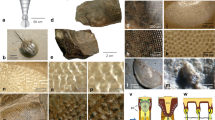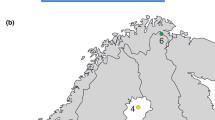Summary
Eye diameter relative to body length, and interommatidial angle, rhabdom length and rhabdom width as a function of eye size, were determined for specimens of 19 benthic macruran decapod species in 8 genera and 5 families, spanning a wide range of habitat depths. For these species, eye diameter relative to body length tends to increase with adult habitat. In addition, rate of eye growth relative to body growth increases with habitat depth, a trend opposite to that of pelagic crustaceans previously investigated. Interommatidial angle decreases with increasing eye diameter, and therefore with depth for an individual of a particular size. Rhabdom length and width tend to increase with eye diameter. Visual sensitivity may increase with depth among these species as a result of both larger eyes and the associated increase in rhabdom dimensions. Differences in energetic limitations and visual environments might produce the difference in trends of eye size relative to body size between benthic and pelagic crustaceans.
Similar content being viewed by others
References
Ball EE (1977) Fine structure of the compound eyes of the mid-water amphipod Phronima in relation to behavior and habitat. Tissue & Cell 9:521–536
Barak M, Ulitzur S (1980) Bacteral bioluminescence as an early indication of marine fish spoilage. Eur J Appl Microbiol Biotechnol 10:155–165
Beddard FE (1886) Report on the isopoda collected by the HMS Challenger during the years 1872–1876. Challenger Report, vol. 17
Beddard FE (1890) On the minute structure of the eye in some shallow-water and deep-sea species of the isopod genus Acturus. Proc Zool Soc London 26:365–375
Bursey CR (1975) The microanatomy of the compound eye of Munida irrasa (Decapoda: Galatheida). Cell Tissue Res 160:505–514
Childress JJ (1971) Respiratory rate and depth of occurrence of midwater animals. Limnol Oceanogr 16:104–106
Childress JJ (1975) The respiratory rates of midwater crustaceans as a function of depth of occurrence and relation to the oxygen minimum layer off Southern California. Comp Biochem Physiol 50A:787–799
Chun C (1896) Atlantis Biologische Studien über pelagische Organismen. Zoologica Stuttgart 7:1–260
Cooper RA, Uzmann JR (1980) Ecology of juvenile and adult Homarus. In: Cobb JS, Phillips BF (eds) The biology and management of lobsters, vol. II. Academic Press, New York, pp 143–178
Denton EJ, Gilpin-Brown JB, Wright PG (1972) The angular distribution of the light produced by some mesopelagic fish in relation to their camouflage. Proc R Soc London B182:145–158
Dobkin S (1965) The early larval stages of Glyphocrangon spinicauda A. Milne Edwards. Bull Mar Sci 15:872–884
Hanstrom B (1983) Neue Untersuchungen über Sinnesorgane und Nervensystem der Crustaceen. II. Zool Jahrb Abt Anat Ontog Tiere 56:387–520
Hiller-Adams P, Case JF (1984) Optical parameters of euphausiid eyes as a function of habitat depth. J Comp Physiol 154:307–318
Karl DM, LaRock PA, Morse JW, Sturges W (1976) Adenosine triphosphate in the North Atlantic Ocean and its relationship to the oxygen minimum. Deep-Sea Res 23:81–88
Kampa EM (1965) The euphausiid eye — a re-evaluation. Vision Res 5:475–481
Kirschfeld K (1974) The absolute sensitivity of lens and compound eyes. Zt Naturforsch 29C:592–596
Land MF (1979) Optics and vision in invertebrates. In: Autrum H (ed) Handbook of sensory physiology, vol VII/6B. Springer, Berlin-Heidelberg-New York, pp 471–592
Land MF (1981) Optics of the eyes of Phronima and other deep-sea amphipods. J Comp Physiol 145:209–226
Land MF, Burton FA, Meyer-Rochow VB (1979) The optical geometry of euphausiid eyes. J Comp Physiol 130:49–62
Latz MI, Case JF (1982) Light organ and eyestalk compensation to body tilt in the luminescent midwater shrimp, Sergestes similis. J Exp Biol 98:83–104
Locket NA (1977) Adaptations to the deep-sea environment. In: Crescitelli F (ed) Handbook of sensory physiology, vol VII/5. Springer, Berlin — Heidelberg — New York, pp 67–192
Loew ER (1976) Light, and photoreceptor degeneration in the Norway lobster, Nephrops norvegicus (L). Proc R Soc London B193:31–44
Meyer-Rochow VB, Walsh S (1977) The eyes of mesopelagic crustaceans: I. Gennadus sp. (Penaeidae). Cell Tissue Res 184:87–101
Mickel TJ, Childress JJ (1982) Effects of temperature, pressure, and oxygen concentration on the oxygen consumption rate of the hydrothermal vent crab Bythograea thermydron (Brachyura). Physiol Zool 55:199–207
Murray J, Hjort J (1912) The depths of the ocean. MacMillan and Co., London, pp 821
Schmitt WL (1921) The marine decapod crustacea of California. University of California Publications in Zoology, vol 23
Smith SI (1886) The abyssal decapod crustacea of the ‘Albatross’ dredgings in the North Atlantic. Ann Mag Nat Hist, Ser 5, 17:187–198
Warner JA, Latz MI, Case JF (1979) Cryptic bioluminescence in a midwater shrimp. Science 203:1109–1110
Welsh JH, Chace FA (1937) Eyes of deep-sea crustaceans. I. Acanthephyridae. Biol Bull 72:57–74
Welsh JH, Chace FA (1938) Eyes of deep-sea crustaceans. II. Sergestidae. Biol Bull 74:364–375
Wenner EL (1978) Comparative biology of four species of glyphocrangonid and crangonid shrimp from the continental slope of the middle Atlantic Bight. Can J Zool 56:1052–1065
Widder EA, Latz MI, Case JF (1983) Marine bioluminescence spectra measured with an optical multichannel detection system. Biol Bull 165:791–810
Zharkova IS (1970) Reduction of the organs of vision in deep-sea mysids. Zool Zh 49:685–693
Zharkova IS (1973) Histological structure of the eye in three representatives of Munidopsis (Crustacea, Decapoda). Zool Zh 52:1643–1647
Zharkova IS (1975) Reduction of organs of sight in deep-water Isopoda, Amphipoda and Decapoda. Zool Zh 54:200–208
Author information
Authors and Affiliations
Rights and permissions
About this article
Cite this article
Hiller-Adams, P., Case, J.F. Optical parameters of the eyes of some benthic decapods as a function of habitat depth (Crustacea, Decapoda). Zoomorphology 105, 108–113 (1985). https://doi.org/10.1007/BF00312145
Received:
Issue Date:
DOI: https://doi.org/10.1007/BF00312145




